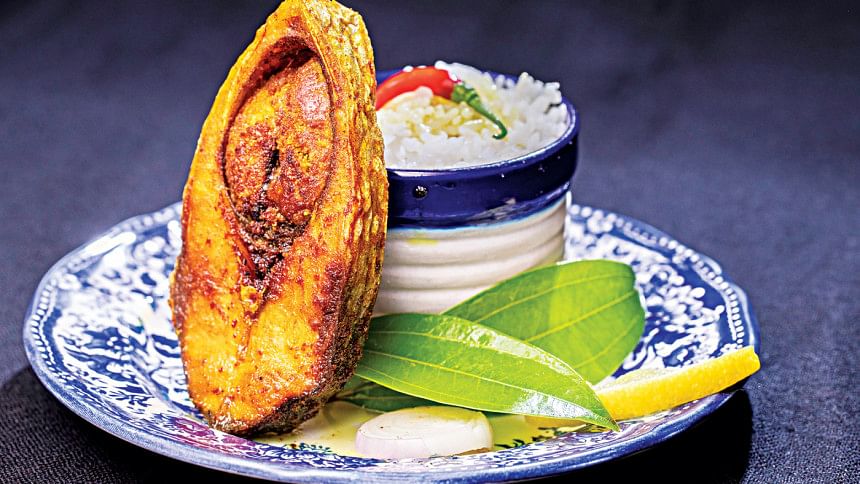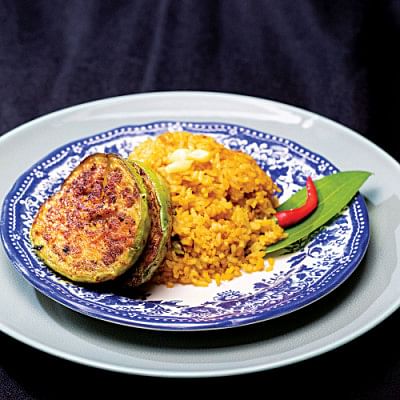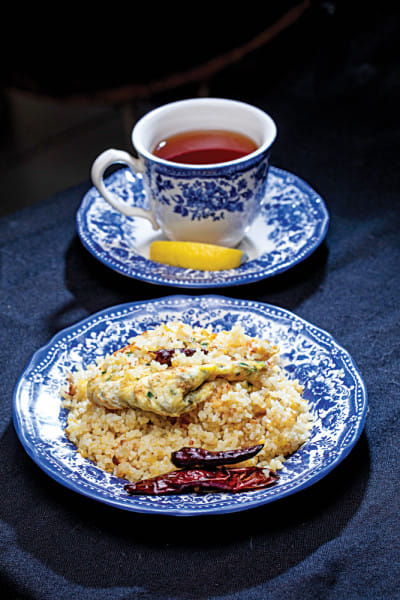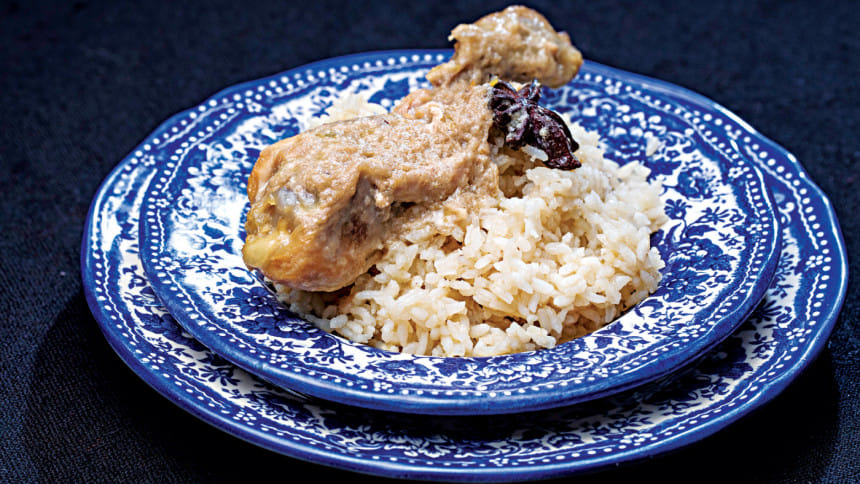The rice story


Back in the days of yore, on a visit to my paternal grandfather's house in Nilphamari, a particular sight caught my fledgling eyes, 8-10 people sitting on a floor-mat laid out in the veranda and eating heartily. They were farmers, also known as 'proja' in the area. Grandmother used to feed them with buckets full of tinted rice, vegetables, green chillies and onions. Sometime later, I noticed a peculiarity regarding the rice — it didn't resemble the typical variant which we regularly consumed as bhaat or khichuri. The grains were comparatively smaller and rounded. Later, I came to know that it was known as the Kaun —a common produce in the northern regions. The poor and the underprivileged commonly enjoyed a plate of this unique variety of rice as it was nutrition heavy, and made a person feel fuller for longer.
On another instance, I saw the same people preparing a special dish out of ripe jackfruit and kaunrice. They sliced the fruit in half and mixed the contents with kaun. This certainly increased my curiosity for the special variety and my grandmother, having sensed my interest, offered me a plate, added with onions, oil, mashed potatoes and fried egg. My aunt also offered a plate of kaun rice pudding with thickened milk. Oh! What a delicacy it was.

In the later years of my life, I saw the same variety of rice in the organic stores of Dhaka. The stores were selling the same thing at a much higher price. The years have also taught me that with kaun, we could prepare a dish of plain rice, khichuri (hotchpotch) and even rice pudding. But I was still sceptical about the taste of kaun and jackfruit as a combination!
A similar narrative that I experienced was with chipped rice or the khude bhaat. Back in the day, when it was commonplace, and almost a ritual to wash and clean rice at home, broken bits were separated and fed to the poor. Sometimes even 'chipped pilaf' was cooked as a delicacy. Overtime, this ritual of cooking pilaf with broken bits of specialty rice was given a name – boukhud.
In Mymensingh, the same preparation is known as boubhaat. Nowadays, in many restaurants we get to see the same preparation of boukhud alongside regular pilaf rice. Boukhud entails, chipped rice khichuri (hotchpotch) prepared with a dash of ginger, turmeric, dried chillies and onions stirred into the mixture. This dish needs to be accompanied with spicy eggplant, potatoes, dried fish, and a fried mixture of mashed black cumin and mustard.
This special rice can also be an exclusive item for breakfast. Another interesting menu that could be the prepared with the khude bhaat is the semolina-rice pudding.
A particular variety of rice that is famous in the regions of Sylhet and Chattogram is the bashful. The breath-taking aroma can be experienced at most restaurants in both of these districts. The specialty rice is fine-looking, almost like basmati. However, these look very different when uncooked; usually shorter and plumper in shape; when cooked the grains lengthen to incredible proportions, with excellent aroma and taste.
On most occasions in these districts, the bashful rice is often cooked in combination with fish, mutton rezala, skinny fries, thickened shonamug lentils, mashed-fried vegetables and murighonto — a spicy aromatic dish entailing fish head and flavoured rice. A vegetable concoction or a vegan khichuri is also a popular item prepared with the bashful.
Not long ago, in Bangladesh, people used to make rice cakes and hotchpotch out of atapchaal. Even today, the plump variety of this special rice is available at certain rice markets. However, atap is not a good selection for the preparation of pilaf; instead, in bigger-scale ceremonies, the atap khichuri is primed with a significant dose of milk.

A popular poem, 'The Servant Boy,' by Jagindranath Sarkar continuously reminds me of the Dadkhani rice — Dadkhani chaal, moshurir daal, chini-pata doi…
This very dadkhani rice from the poem, used to be quite popular in the yesteryears, especially because of the medicinal properties of the rice. It is full of zinc, a mineral that is useful to treat diseases. And hence, as a treatment possibility, the dadkhani was offered to the sick as essential food. It is still available at few notable rice bazaars.
If we closely observe the history of Bengal, we can see that there were more than 200 varieties of rice cultivated in this part of the region. Each variety was easily distinguishable from the other, based on colour, shape, and taste.
The types also varied with the seasons. Due to the tremendous increase in population and scarcity in the number of farming lands, most of the varieties, especially the sensitive ones, could not be cultivated any longer. One example could be the raida rice, which is commonly known as the 'mother of rice.' There is even folklore associated with this particular variety — It is said that in the regions of Khulna, fishermen used to roam around the banks of the river in search of food. While doing so, one time, they took some dry grass from the fields around them and used it as fire-starter to make fish fry. And as the ashes fell back onto the lands, it caused the raida variety of rice to propagate. So essentially, the folklore depicts that the raida grows from the grasses.
Raida is essentially a blessing for the culinary world. It helps in the preparation of excellent quality rice pudding and pilaf. Farmers have begun to cultivate this special variety again, similar to the yesteryears.
Other variants in the name of kajal digha, Lakshmi digha and kalarai can withstand flood. There are some more variants by the name of vaad, kaloshoni, and kumri, which can be cultivated even during times of famine. Based on climate change and our current weather conditions, it is almost necessary that we take the initiative to grow these variants again.
Shifting cultivation (jhum chaash) helps produce aspecial rice variety in the name of binni. Upon cooking the binni converts into black, red and white variants of sticky rice. This type of rice is extremely tasty, quite a bit sticky and good for making hotchpotch and plain rice.
Sticky rice is expected to be eaten warm; otherwise it becomes too thick for consumption. Khichuri prepared with moong daal (lentil) and sticky rice is out-of-the-world appetising, and so are the rice cakes and rice pudding prepared with the same item.
Yousuf, a farmer from Dubail, Rajshahi, who has been farming for the last fifty years, has been successful in cultivating over 150 varieties of rice on his lands. Yousuf wishes to see other farmers get back into the habit of cultivating the long-lost variants of rice, like himself. He wants to celebrate the Bengali New Year with these farmers, preparing different items with the many varieties of rice, and feed the guests at the festival with their unique preparations.
If time permits, it certainly would be an honour to be able to visit the New Year's festivities at Yousuf's place in Dubail.
By Shahana Huda Ranjana
Translated by Mehrin Mubdi Chowdhury
Photo: Sazzad Ibne Sayed
Food and Styling: RBR

 For all latest news, follow The Daily Star's Google News channel.
For all latest news, follow The Daily Star's Google News channel. 



Comments